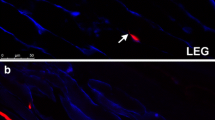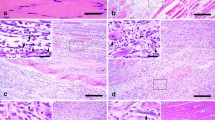Abstract
Local anesthetics, particularly bupivacaine, are known to be myotoxic to skeletal muscle. Injury is followed by satellite cell mediated regeneration. The eyelid is a common site for the injection of local anesthetics. Due to the complex anatomy of this region and the unique properties of facial musculature compared to limb skeletal muscle, the response of the orbicularis oculi to local injection of bupivacaine was examined to determine the time course of maximum satellite cell activation and division. The lower eyelids of rabbits were injected with two doses of a combination of bupivacaine and hyaluronidase, spaced 18 h apart. To assess the time course of satellite cell division, bromodeoxyuridine (BrdU) was injected immediately or, 1, 2, 3, 6 or 13 days after the second bupivacaine injury. The rabbits were sacrificed 24 h later. The eyelids were prepared for immunohistological examination and morphometric analysis of the presence of CD11-positive monocytes, neutrophils and macrophages, MyoD expression in satellite cells and/or myoblasts, and co-expression of BrdU and the developmental myosin heavy chain isoform. One day after bupivacaine injury of the orbicularis oculi, there was a large influx of CD11-positive cells which gradually decreased over time. Maximum activation of satellite cells, as defined by MyoD expression, occurred 2 and 3 days after the injury. Using double labeling techniques, the peak of BrdU incorporation occurred on day 3 and was identified in developmental myosin co-labeled cells 4 days after injury. The peak of satellite cell activation and division occurred 3 days after bupivacaine induced injury, as demonstrated by both MyoD expression and after pulse labeling with BrdU as identified in double labeled cells positive for BrdU and the developmental myosin heavy chain isoform. The process of regeneration in this muscle extended beyond the duration of this study. Muscle fibers remained small in cross-sectional area and positive for developmental myosin 2 weeks after injury, at a time when the fiber number had reached control, uninjured levels.
Similar content being viewed by others
Author information
Authors and Affiliations
Additional information
Received: 30 December 1997 / Accepted: 5 June 1998
Rights and permissions
About this article
Cite this article
McLoon, L., Nguyen, L. & Wirtschafter, J. Time course of the regenerative response in bupivacaine injured orbicularis oculi muscle. Cell Tissue Res 294, 439–447 (1998). https://doi.org/10.1007/s004410051195
Issue Date:
DOI: https://doi.org/10.1007/s004410051195




